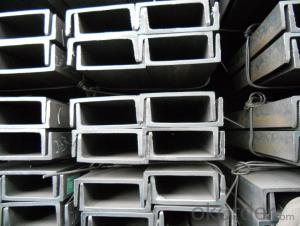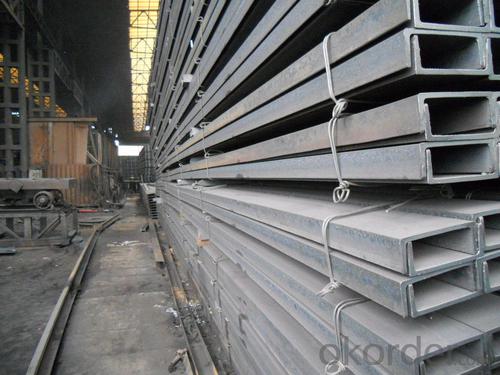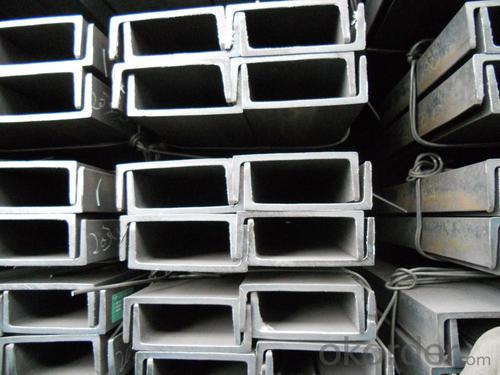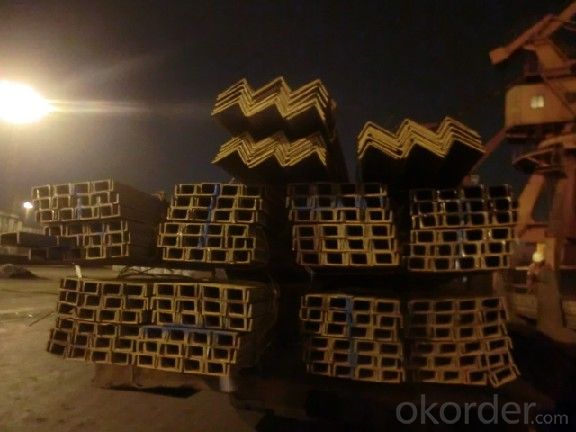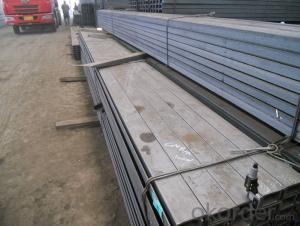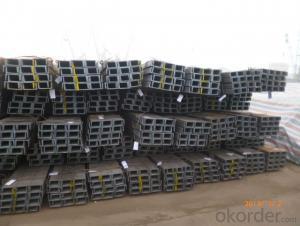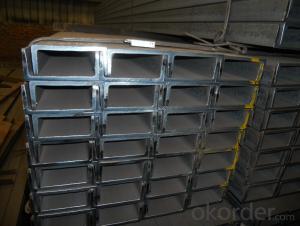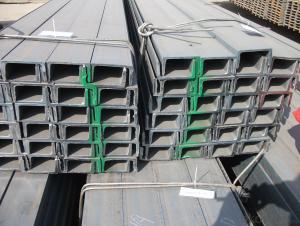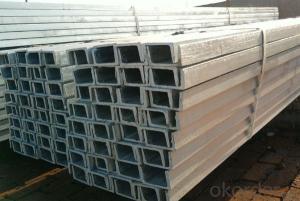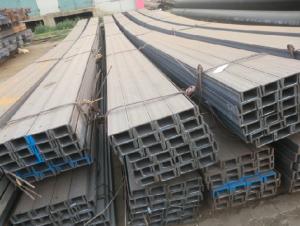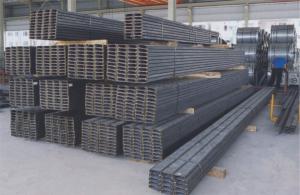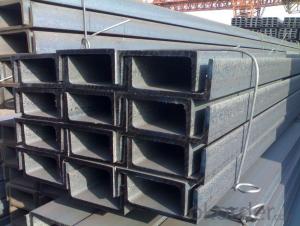U-channel JIS Standard with Different Sizes Hot Rolled
- Loading Port:
- Tianjin
- Payment Terms:
- TT OR LC
- Min Order Qty:
- 25 m.t.
- Supply Capability:
- 2000 m.t./month
OKorder Service Pledge
OKorder Financial Service
You Might Also Like
Product Description:
OKorder is offering U-channel at great prices with worldwide shipping. Our supplier is a world-class manufacturer of steel, with our products utilized the world over. OKorder annually supplies products to European, North American and Asian markets. We provide quotations within 24 hours of receiving an inquiry and guarantee competitive prices.
Product Applications:
1.The JIS channel can be devided into two kinds, namely common channel steel and light channel steel. The sizes of hot rolled common channel steel range from 5# to 40#. Meanwhile, the channel steel can be divided into cold forming sectional equal channel steel, cold forming sectional unequal channel steel, cold forming inner edge channel steel and outer edge channel steel.
2.The JIS channel is usually used for arch-itechtural structure, and they could be welded in order to support or hang a vari-ety of facilities. They are also usually used in combination with I beam. The channel steel with sizes under 14# is usually applied to construction engineering, as purline, while the channel steel with sizes above 16# is more likely to be used in building vehicle chassis structure and mechanical structure. Furthermore, the channel steel in sizes above 30# are target at building bridge structure, as tension bar.
Product Advantages:
OKorder's U-channel are durable, strong, and resist corrosion.
Main Product Features:
· Premium quality
· Prompt delivery & seaworthy packing (30 days after receiving deposit)
· Corrosion resistance
· Can be recycled and reused
· Mill test certification
· Professional Service
· Competitive pricing
Product Specifications:
1.We are able to provide channel steel of top quality at attractive price.
2.Our products of channel steel have passed ISO9001:2008 Quality Management System Certification.
Alloy No | Grade | Element (%) | |||||
C | Mn | S | P | Si | |||
Q235 | B | 0.12—0.20 | 0.3—0.7 | ≤0.045 | ≤0.045 | ≤0.3 | |
Alloy No | Grade | Yielding strength point( Mpa) | |||||
Thickness (mm) | |||||||
≤16 | >16--40 | >40--60 | >60--100 | ||||
≥ | |||||||
Q235 | B | 235 | 225 | 215 | 205 | ||
Alloy No | Grade | Tensile strength (Mpa) | Elongation after fracture (%) | ||||
Thickness (mm) | |||||||
≤16 | >16--40 | >40--60 | >60--100 | ||||
≥ | |||||||
Q235 | B | 375--500 | 26 | 25 | 24 | 23 | |
FAQ:
Q1: How soon can we receive the product after purchase?
A1: Within three days of placing an order, we will begin production. The specific shipping date is dependent upon international and government factors, but is typically 7 to 10 workdays.
Q2: What makes stainless steel stainless?
A2: Stainless steel must contain at least 10.5 % chromium. It is this element that reacts with the oxygen in the air to form a complex chrome-oxide surface layer that is invisible but strong enough to prevent further oxygen from "staining" (rusting) the surface. Higher levels of chromium and the addition of other alloying elements such as nickel and molybdenum enhance this surface layer and improve the corrosion resistance of the stainless material.
Q3: Can stainless steel rust?
A3: Stainless does not "rust" as you think of regular steel rusting with a red oxide on the surface that flakes off. If you see red rust it is probably due to some iron particles that have contaminated the surface of the stainless steel and it is these iron particles that are rusting. Look at the source of the rusting and see if you can remove it from the surface.
Images:
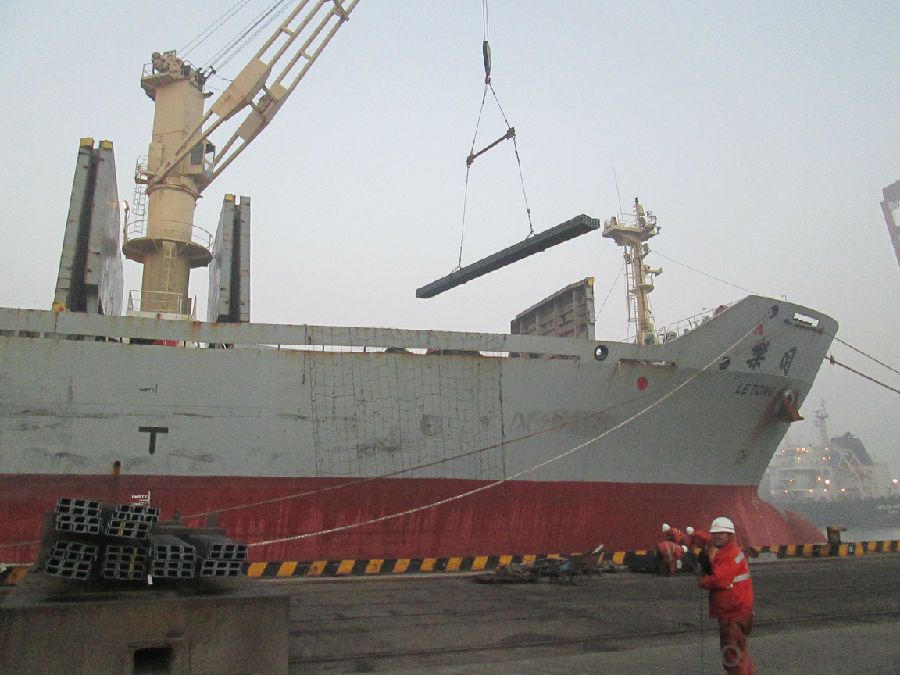
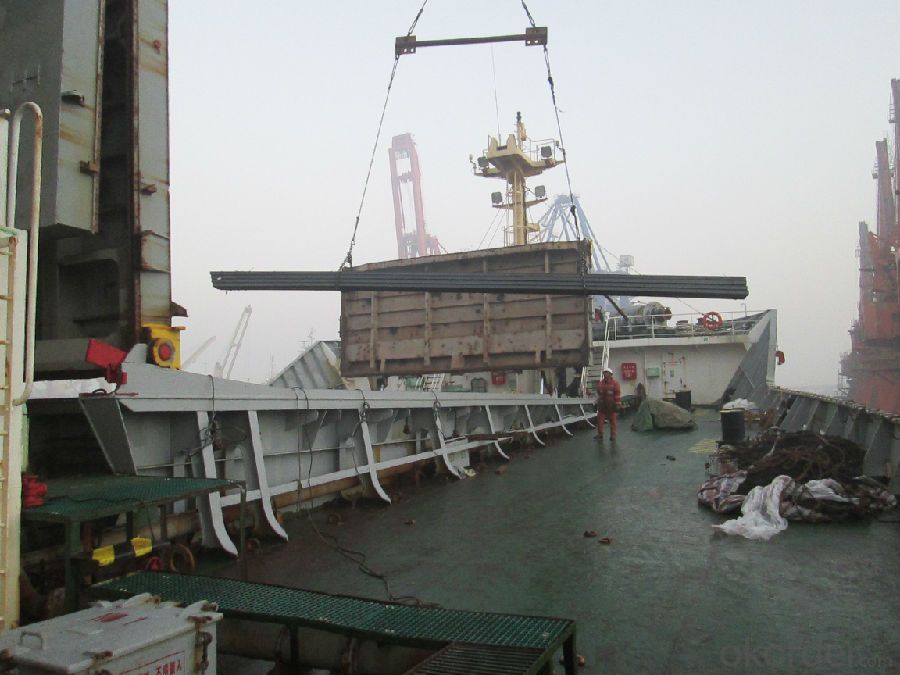
- Q: What are the different surface treatments available for steel channels in corrosive environments?
- Some common surface treatments for steel channels in corrosive environments include hot-dip galvanizing, epoxy coating, and stainless steel cladding. These treatments provide protection against corrosion by creating a barrier between the steel and the corrosive elements present in the environment.
- Q: What are the different joining methods for steel channels?
- There are several different joining methods for steel channels, each with its own advantages and disadvantages. 1. Welding: This is one of the most common methods used to join steel channels. It involves heating the edges of the channels and melting them together, creating a strong and permanent bond. Welding can be done using various techniques such as arc welding, MIG welding, or TIG welding. However, welding can be time-consuming and requires skilled labor. 2. Bolting: Bolting is another common method used to join steel channels. It involves using bolts or screws to secure the channels together. This method is relatively quick and easy, allowing for easy disassembly and reassembly if necessary. However, it may not provide as strong of a connection as welding. 3. Riveting: Riveting involves using metal rivets to join steel channels. Rivets are inserted into pre-drilled holes in the channels, and then deformed to create a secure connection. Riveting provides a strong and durable joint, but it can be time-consuming and requires special tools. 4. Adhesive bonding: Adhesive bonding involves using specialized adhesives to join steel channels. The adhesive is applied to the surfaces to be joined and then allowed to cure, creating a strong bond. This method is often used when aesthetics are a concern since it does not leave any visible fasteners. However, adhesive bonding may not be as strong as other joining methods and may require surface preparation for proper adhesion. 5. Mechanical fasteners: Mechanical fasteners such as clips, brackets, or clamps can also be used to join steel channels. These fasteners are typically designed to provide a secure and adjustable connection. They can be easily installed and removed, making them suitable for temporary or adjustable structures. However, they may not provide the same level of strength as other joining methods. Overall, the choice of joining method for steel channels depends on various factors such as strength requirements, ease of installation, disassembly needs, and aesthetics. It is essential to consider these factors and select the most appropriate joining method for each specific application.
- Q: How do steel channels contribute to the overall thermal insulation of a structure?
- Steel channels do not directly contribute to the overall thermal insulation of a structure. However, they can play a role in supporting and securing insulation materials that are used for thermal insulation. Insulation materials, such as foam boards or fiberglass, are typically installed between the structural framing members of a building to reduce heat transfer. Steel channels, being a part of the structural framework, can provide the required support for these insulation materials. By securing the insulation materials in place, steel channels help prevent any movement or displacement that could compromise the effectiveness of the insulation. Additionally, steel channels can also act as a barrier, preventing the insulation from being compressed or damaged during construction or over time. Furthermore, steel channels can be used to create airtight seals around the edges of insulation materials. This helps to minimize air leakage and improve the overall thermal performance of the structure. In summary, while steel channels themselves do not contribute to thermal insulation, they play a crucial role in supporting and securing insulation materials, ensuring their effectiveness and enhancing the overall thermal insulation of a structure.
- Q: 10# how much is it per kilogram of channel steel?
- Cold rolling edge channel (CJ/YB99-81 standard standard)The height of =120, legs wide =60, short width =20, thickness =3, leg end arc radius =3.0, cross-sectional area (cm2) =7.808, (kg/m) =6.090 theoretical weight (legs bent inward kind)If the non target is not necessarily.
- Q: Can steel channels be used for creating support structures for communication towers?
- Indeed, support structures for communication towers can be constructed using steel channels. Owing to their robustness and enduring nature, steel channels are frequently employed in the realm of construction. They offer exceptional reinforcement for substantial burdens and can endure diverse environmental circumstances, rendering them fitting for integration in communication tower structures. The fabrication, cutting, and welding of steel channels to fulfill the precise demands of the tower design can be accomplished with ease. Furthermore, their symmetrical form and unwavering measurements render them optimal for establishing steadfast and dependable support structures.
- Q: How do steel channels contribute to ventilation in structures?
- Ventilation in structures can be enhanced through various means, with steel channels being a key contributor. Primarily, these channels serve as vital components of ventilation systems, effectively guiding and dispersing airflow throughout the building. By strategically positioning them, a constant supply of fresh air can be brought in while eliminating stagnant air. Moreover, steel channels serve a secondary purpose by providing support for ventilation equipment, including fans, blowers, and air conditioning units. By securely affixing these devices onto the channels, they can efficiently circulate and distribute air throughout the entire structure. In addition, steel channels offer the opportunity to construct air ducts within the building. These ducts facilitate the movement of air from one area to another, ensuring proper distribution and reaching all corners of the structure. By employing steel channels for this purpose, the ducts become robust, long-lasting, and resistant to damage, ultimately resulting in efficient and enduring ventilation. In conclusion, steel channels play an indispensable role in the ventilation of structures. Not only do they provide support for ventilation equipment, but they also assist in directing airflow and creating durable air ducts. By incorporating steel channels into ventilation systems, structures can maintain optimal air quality, temperature, and circulation, thus fostering a comfortable and healthy environment for occupants.
- Q: Can steel channels be used for creating overhead support structures?
- Yes, steel channels can be used for creating overhead support structures. Steel channels are commonly used in construction and engineering projects for their strength and durability. They provide excellent support and can be used to create beams, trusses, and frames for overhead structures such as bridges, walkways, and canopies. Steel channels have high load-bearing capacities and can withstand heavy weights and forces, making them suitable for creating reliable and long-lasting overhead support structures.
- Q: Standard size and price of 12# channel steel...
- 12# ordinary channel steel, high 120mm legs wide, 53mm waist thick 5,5mm, weighing 12,06 kg per meter --- (GB707-65 standard)12# light channel steel, high 120mm legs wide, 52mm waist thick 4,8mm, weighing 10,4 kg per meter ---- (YB164-63 standard)The price is about 3850 yuan / ton at presentLength 5~19 meters
- Q: Are steel channels suitable for DIY projects?
- For DIY projects, steel channels are a suitable option. With their versatility and sturdiness, steel channels are ideal for a range of DIY applications. You can utilize them to construct shelves, workbenches, frames, and supports for different structures. By using steel channels, you can ensure that your DIY project will be strong and long-lasting because of their excellent strength and durability. Moreover, steel channels are easily obtainable in various sizes and lengths, making it effortless to find the right dimensions for your project. Additionally, they are relatively easy to work with, allowing DIY enthusiasts to cut, drill, and weld them as necessary. All things considered, steel channels are an excellent choice for DIY projects, thanks to their strength, versatility, and availability.
- Q: What are the different types of connections for steel channels in modular office systems?
- There are various types of connections used for steel channels in modular office systems, including bolted connections, welded connections, and adjustable connections. Bolted connections involve using bolts and nuts to secure the channels together, providing flexibility for disassembly and reassembly. Welded connections involve fusing the steel channels together using heat, creating a strong and permanent connection. Adjustable connections allow for fine-tuning and leveling of the channels, ensuring proper alignment and stability in the modular office system.
Send your message to us
U-channel JIS Standard with Different Sizes Hot Rolled
- Loading Port:
- Tianjin
- Payment Terms:
- TT OR LC
- Min Order Qty:
- 25 m.t.
- Supply Capability:
- 2000 m.t./month
OKorder Service Pledge
OKorder Financial Service
Similar products
Hot products
Hot Searches
Related keywords

